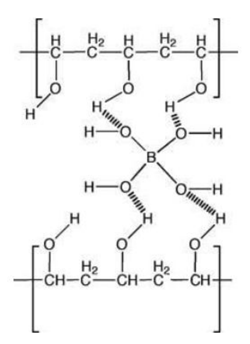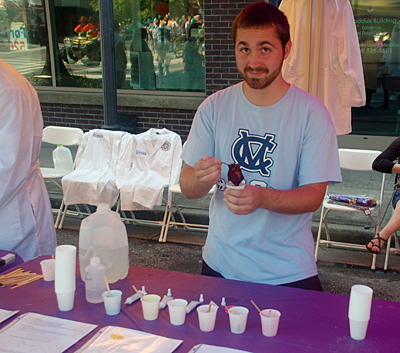Introduction
Multi-colored slime can be created using a solution of poly-vinyl alcohol (PVA) and borax. This experiment demonstrates the ability of borax to form chemical cross-links between molecules of the PVA polymer. The chemical structures below show a molecule of the PVA polymer on the left and a molecule of borax (borate ion) on the right.

When these molecules are mixed together, hydrogen bonds are formed between the hydroxyl groups of both the PVA and borate ion. This “sticks” them together and creates the slimy texture to the mixture.

Slime is a non-Newtonian fluid that dilate, or expand, under stress. Similar substances with these properties include quicksand, starch solutions and Silly Putty. Dilatant materials tend to have some unusual properties.
If you slowly pull on the material, it will flow and stretch. If you are very careful, you can form a thin film. But if you pull sharply (inducing high stress), the material will break. If you pour the material from its container and tip the container slightly upwards, the gel will siphon itself.
Materials
- 2 L soda bottles (remove the label)
- Small disposable cups
- Plastic spoons or wooded stirrers
- 4% Poly-Vinyl Alcohol (PVA) solution
- 4% Borax solution
- Food coloring
- ZipLoc Bags
- Wax Paper or Tarp for easy cleanup
- 0.5 M Hydrochloric Acid (HCl) (optional)
- 0.5 M Sodium Hydroxide (NaOH) (optional)
Procedure
- Prior to the demonstration, prepare the Poly-Vinyl Alcohol (PVA) solution by adding 4 g of PVA to 100 mL of hot, deionized water (70°C). You may use a microwave to heat the water. Put the 4% PVA solution into 2 L soda bottles for storage. Prepare the 4% borax solution by mixing 4 g Na2B4O7 in 100 mL of deionized water.
- At the demonstration, perform all mixing of PVA and borax on the wax paper or tarp. You will mix the two solutions together in a 10:1 (PVA:borax) ratio in the small cups provide. Add two to four drops of food coloring of the desired color. Mix well using the plastic spoon or wooden stirrers. A gel should form immediately.
- Demonstrate the flexibility and pliability of the gel.
- Optional: Adding acid (HCl) to the slime breaks the crosslinking and produces a liquid with lower viscosity. If you add a base (NaOH), the process is reversed and the slime is regenerated.
- The slime can be taken home by storing it in a ZipLoc bag.
Safety
Wear eye protection and latex gloves when handling slime.
Disposal of Waste Products
All waste products may be safely disposed of in the garbage.

